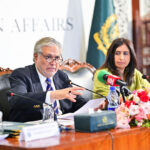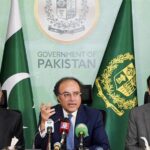PESHAWAR, Sep 22 (APP): Unaware of the famous Peshawari Qehwa being sold at his shop at historic Ghanta Ghar, Barukat Ali (40), a progressive fisherman was working against the clock to fulfill the order placed by a marriage hall in the bustling city known for the mouthwatering food cuisines and hospitality.
Cleaning Rahu, shermai, mahsher, and grass carp with the help of three labourers, Barkatullah who was surrounded by a huge stock unloaded by his brother at Ghanta Ghar fish market established in 1980, was seen repeatedly asking to expedite its packing for timely transportation to the customers at Gul Bahar Peshawar City by Saturday afternoon.
“Following unprecedented hike in prices of meat of sacrificial animals and chicken, the culture of serving guests with seafood during walima and birthday parties was making inroads in Khyber Pakhtunkhwa, especially in Peshawar besides an increase of hotels’ fish demands, making a positive economic impact on people’s associated with this business,” he said while cleaning perspirations with a white handkerchief with beaming siren of tsunami rickshaws.
“After graduation, I had jumped to this profitable business 18 years ago for failing to find a government job, but today, I am living a dignified life besides providing employment to three labourers,” he said, adding about two to three lakh people were directly and indirectly associated with the fisheries sector in KP.
Barkat said KP’s native fish were most suited to traders of Peshawar from an economic point of view compared to Karachi and Balochistan due to transportation costs.
Muhammad Zubair Khan, Director Fisheries Department said that Pakistan was blessed with numerous water resources in forms of marine, saline, and fresh water reservoirs where varieties of aquatics flora and fauna were found in abundance, adding 531 fish species were reared in the country including 233 of fresh water of rivers, lakes and ponds in the province.
In Pakistan, he said that freshwater ponds cover 60,470 hectares area and natural warm water lakes were spread on 110,000 hectares, adding Malakand and Hazara divisions besides Kurram tribal district were most suited for trout fish farming due to cold temperature and water.
Despite many health benefits, he said that fish consumption was about one percent in Pakistan where per capita consumption per year was only 2 KG while per capita consumption in the world was 17 kilograms per annum.
Professor Dr Muhammad Naeem of the Economics Department, University of Swabi said that fish farming was a highly profitable business and the country’s economic problems could be addressed by giving financial incentives to fish farmers.
Earning over Rs12.40 billion from fish exports during the last fiscal year, Pakistan’s seafood exports would be further increased with China and other neighboring countries after the completion of CPEC, he added.
“The total fish production during the financial year 2016-17 was about 477,000 MT (metric ton) out of which 332,000MT received through marine resources while remaining obtained through inland fisheries,” he said, adding this production was only 8,430MT in 2010.
Similarly, out of 482,000 MT production was recorded in 2017-18 out of which 338,000MT was achieved from marine resources and the remaining from inland reservoirs. During 2019-20, around 701,726 MT of fish were produced out of which 474,025 MT were from marine, and a 1.5 percent deduction was witnessed during 2020-21 due to overfishing in rivers, ponds, and other shrinking resources.
He said an additional 53,000MT fish production would be required by 2030 if our population growth continued at such an alarming rate.
“The indigenous shermai fish mostly found in River Kabul, is under heightening danger due to water pollution, overfishing, and climate change’s vulnerabilities,” he said, adding that ban on hunting of shermai and discharge of contaminated water of marble industrial units of Warsak Road Peshawar and Mohmand district into River Kabul may be imposed to save endangered species from its possible extinction.
Director Fisheries Zubair said, “Shermai being a sensitive species needs more oxygen than other types of fish in water for survival and breeding.”
Directives were issued to field staff to take strict action under the laws against elements involved in its illegal hunting, especially through nets and electric currents, he added.
General Secretary (GS) of the Swat Trout Fish Farming Association, Usman Ali said that around 220 trout and carp farms in Swat Valley were damaged by the year 2022 devastated floods and demanded a compensation package.
“Any farmer having 50 marla land and proper water inflow and outflow system can produce 3,000 kg trout by earning about Rs2.5 million profit after 15 to 18 months raring. One kilogram trout in the open market was being sold at Rs 2200 to Rs 2500 per kilogram and the production increased further in case of quality breeding.”
He said, “Pakistan can earn substantial revenue by giving special incentives to trout farmers besides the construction of new trout lakes especially in Malakand and Hazara divisions, and giving it the status of an industry.”
Zubair said trout village projects in Hazara and Malakand divisions were launched under which 93 trout fish farms were established under a 50:50% cost-sharing formula basis. A model trout hatchery was set up at Salathanar Upper Swat on 15 Kanal with the capacity to produce six million fish seeds per year.
The development of a cold water fisheries resources project costing Rs 1200 million, a joint venture of Federal and Provincial Governments having a 40:60pc cost-sharing basis, was in progress in Malakand and Hazara divisions under which 297 trout lakes were being established.
He said, “The development of reservoirs for the uplift of fisheries resources project costing Rs 500 million has been approved under which 67 carp fish farms and model hatchery on 179 kanal at Swabi will be established from where fish seedlings to be provided to private hatcheries and Turbella dam.”
With the completion of these projects, he said the KP’s fish production would likely increase to 740 metric tons from the existing 400 metric tons by 2024. Terming water pollution and climate change as a big threat to trout farming, the official suggested a comprehensive mechanism for disposal of hotel waste in the Malakand and Hazara divisions.
Work on the ‘development of fisheries resources in merged areas’ has been started under which Rs 220 million is to be spent in the first phase, adding that model coldwater research center established at Madyn Swat with a facility of a fish hatchery where academia and young researchers being facilitated to conduct researches on different issues of aquatic resources.
APP/fam/taj (APP Feature Service)




